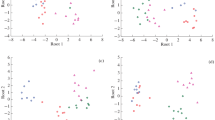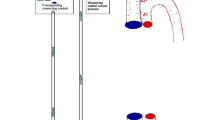Summary
Dose-dependent effects of the dihydrogenated ergot alkaloid dihydroergocristine on physiological variables, local cerebral blood flow (LCBF) and local cerebral glucose utilization (LCGU) were evaluated in the conscious rat after intravenous injection. Heart rate was reduced with 2.5 mg/kg and 20 mg/kg dihydroergocristine. LCBF and LCGU were determined autoradiographically by employing the 14C-iodoantipyrine or 14C-2-deoxyglucose technique, respectively. At a dose of 0.5 mg/kg, dihydroergocristine neither changed LCGU nor LCBF, while at 2.5 mg/kg a slight decrease in LCGU was measured, which was more pronounced at 20 mg/kg. LCBF was significantly increased in several structures at 2.5 mg/kg, but it was markedly reduced at 20 mg/kg. The divergent effects on LCBF and LCGU at a dose of 2.5 mg/kg suggest a potential capacity of dihydroergocristine to uncouple the close interrelation of cerebral blood flow and cerebral energy metabolism.
Similar content being viewed by others
References
Beck T, Vogg P, Krieglstein J (1986) Effects of the indirect dopaminomimetic diethylpemoline on local cerebral glucose utilization and local cerebral blood flow in the conscious rat. Eur J Pharmacol 125:437–447
Beck T, Krieglstein J (1987) Cerebral circulation, metabolism, and blood-brain barrier of rats in hypocapnic hypoxia. Am J Physiol 252:H504-H512
Emmeneger H, Meier-Ruge W (1968) The actions of hydergine on the brain. A histochemical circulatory and neurophysiological study. Pharmacology 1:65–78
Enz A, Iwangoff P, Chappuis A (1978) The influence of dihydroergocristine mesylate on the low-K m phosphodiesterase of cat and rat brain in vitro. Gerontology 24 (Suppl 1):115–125
Géraud J, Bes A, Rascol A, Delpla M, Marc-Vergnes JP (1963) Mésure du debit sanguin cerebral au krypton 85. Quelques applications physiopathologique et cliniques. Rev Neurol (Paris) 108:542–557
Gottstein U (1962) Der Hirnkreislauf unter dem EinfluB vasoaktiver Substanzen. Hüthig Verlag, Heidelberg
Gottstein U (1965) Pharmacological studies of total cerebral blood flow in man with comments on the possibility of improving regional cerebral blood flow by drugs. Acta Neurol Scand (Suppl) 14:136–141
Gottstein U (1969) The effects of drugs on cerebral blood flow especially in patients of older age. Pharmakopsychiat Neuro-Psychopharmakol 2:100–109
Hafkenschiel JH, Crumpton CW, Moyer JH (1950) The effect of intramuscular dihydroergocornine on the cerebral circulation in normotensive patients. J Pharmacol Exp Ther 98:144–146
Iwangoff P, Enz A (1972) The influence of various dihydroergotamine analogues on cyclic adenosine-3,5 monophosphate phosphordiesterase in the grey matter of cat brain in vitro. Agents Actions 2:223–226
Iwangoff P, Meier-Ruge W, Schieweck Ch, Enz A (1976) The uptake of DH-Ergotoxine by different parts of the cat brain. Pharmacology 14:27–38
Kelly PAT, McCulloch J (1983) A potential error in modifications of 14C-2-deoxyglucose technique. Brain Res 260:172–176
London ED, Walovitch RC (1985) Le métabolisme cerebral du glucose chez les rongeurs ages: action de la co-dergocrine. J Pharmacol (Paris) 16 Suppl III:85–97
MacKenzie ET, Gotti B, Nowicki JP, Young AR (1984) Adrenergic blockers as cerebral antiischaemic agents. In: Neurotransmitters and the cerebral circulation, L.E.R.S. Monograph Series, vol 2. New York, Raven Press, pp 219–243
Markstein TR, Wagner H (1978) Effect of dihydroergotoxine on cyclic-AMP-generating systems in rat cerebral cortex slices. Gerontology 24 (Suppl 1): 94–105
Meier-Ruge W (1986) Effects of prolonged co-dergocrine mesylate (Hydergine) treatment on local cerebral glucose uptake in aged Fischer 344 rats. Arch Gerontol Geriatr 5:65–77
Mongeau B (1974) The effect of Hydergine on the transit time of cerebral circulation in diffuse cerebral insufficiency. Eur J Clin Pharmacol 7:169–175
Morpurgo C, Faini D, Falcone A (1975) Effects of phentolamine, dihydroergocristine and isoxuprine on the blood pressure and heart rate in normotensive, hypotensive and hypertensive rats. Naunyn-Schmiedeberg's Arch Pharmacol 290:335–346
Rachman A, Kellman L, Krieglstein J (1984) Effect of dihydro-ergocristine on energy metabolism studied in the isolated perfused rat brain affected by ischemia and in neuroblastoma cells deprived of oxygen and glucose. J Cereb Blood Flow Metabol 4:610–614
Rapin JR, Le Poncin-Lafitte, Lespinasse P (1984) Simultaneous study of cerebral blood flow, vascular bed and deoxyglucose in aged rats. Effect of two dihydrated ergot alkaloids. Pharmacology 28:241–250
Reivich M, Jehle J, Sokoloff L, Kety SS (1969) Measurement of regional cerebral blood flow with antipyrine-14C in awake cats. J Appl Physiol 27:296–300
Sakurada O, Kennedy C, Jehle J, Brown JD, Carbin GL, Sokoloff L (1978) Measurement of local cerebral blood flow with iodo 14C antipyrine. Am J Physiol 234:H59-H66
Savaki HE, Davidsen L, Smith C, Sokoloff L (1980) Measurement of free glucose turnover in brain. J Neurochem 35:495–502
Savaki HE, Kadekaro M, McCulloch J, Sokoloff L (1982) The central noradrenergic system in the rat: metabolic mapping with alpha-adrenergic blocking agents. Brain Res 234:65–79
Sokoloff L, Reivich M, Kennedy C, DesRosiers MH, Patlak CS, Pettigrew KD, Sakurada O, Shinohara M (1977) The 14C-deoxyglucose method for the measurement of local cerebral glucose utilization: theory, procedure, and normal values in the conscious and anesthetized albino rat. J Neurochem 28:897–916
Szabo L, Kovach AGB, Babosa M (1983) Effect of autonomic blocking agents on local cerebral blood flow in the rat. Acta Physiol Hung 62:191–204
Szewczykowski J, Meyer JS, Kondo A, Nomura F, Teraura T (1970) Effects of ergot alkaloids (Hydergine) on cerebral hemodynamics and oxygen consumption in monkeys. J Neurol Sci 10:25–31
Vaupel P, Hutten H (1980) Akute Veränderungen des intracerebralen GefdBwiderstandes nach Gabe von dihydrierten Ergotoxinalkaloiden. Arzneimittel-Forschung 30:598–602
Wyllie MG, Paciorek PM, Waterfall JF (1981) Adenosine triphosphate conservation by indoramine and other drugs. Biochem Pharmacol 30:1605–1612
Young AR, Bouloy M, Boussard J-F, Edvinsson L, MacKenzie ET (1981) Direct vascular effects of agents used in the pharmacotherapy of cerebrovascular disease on isolated cerebral vessels. J Cereb Blood Flow Metabol 1:117–129
Author information
Authors and Affiliations
Additional information
Send offprint requests to T. Beck at the above address
Rights and permissions
About this article
Cite this article
Beck, T., Vogg, P. & Krieglstein, J. Uncoupling of cerebral blood flow and glucose utilization by dihydroergocristine in the conscious rat. Naunyn-Schmiedeberg's Arch Pharmacol 338, 82–87 (1988). https://doi.org/10.1007/BF00168816
Received:
Accepted:
Issue Date:
DOI: https://doi.org/10.1007/BF00168816




